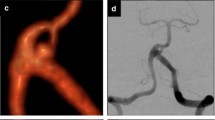Abstract
We report our experience in the endovascular treatment with detachable platinum coils of ruptured or symptomatic unruptured cerebral aneurysms in 61 patients aged 70–82 years. Complete occlusion was achieved in 38, subtotal in 17 and partial in one. The treatment failed in five patients. Clinical follow-up was performed in all patients for 8 months to 8 years. No bleeding occurred during the follow-up period. Outcome was favourable in 63% of the patients. When we compared the outcome of elderly patients with those of younger age endovascularly treated in the same period of time, we found a significantly higher frequency of poorer outcome in the elderly group (χ2=9.084; P=0.011). The frequency of favourable outcome in the elderly was significantly lower than in the younger group for H–H IV–V (χ2=9.299; P=0.010). The most important factor influencing the outcome was not age itself, but primary clinical condition on admission. The therapy of symptomatic aneurysms in elderly patients should not be purely conservative—a direct approach of the aneurysm should be considered. Endovascular treatment whenever possible seems to be a good alternative to surgery.
Similar content being viewed by others
References
Bakke SJ, Pedersen HK, Nome T, Sorteberg W, Lindegaard KF (2003) Outcome in individuals aged 70 years and more with ruptured intracranial aneurysms. Int Neuroradiol 9 [Suppl 2]:163
Fridriksson SM, Hillman J, Saveland H, Brandt L (1995) Intracranial aneurysm surgery in the 8th and 9th decades of life: impact on population-based management outcome. Neurosurgery 37:627–631
Inagawa T (1993) Management outcome in the elderly patient following subarachnoid hemorrhage. J Neurosurg 78:554–561
Johansson M, Cesarini KG, Contant CF, Persson L, Enblad P (2001) Changes in intervention and outcome in elderly patients with subarachnoid hemorrhage. Stroke 32:2845–2949
Lan Q, Ikeda H, Jimbo H, Izumiyama H, Matsumoto K (2000) Considerations on surgical treatment for elderly patients with intracranial aneurysms. Surg Neurol 53:231–238
O’Sullivan MG, Dorward N, Whittle IR, Steers AJ, Miller JD (1994) Management and long-term outcome following subarachnoid haemorrhage and intracranial aneurysm surgery in elderly patients: an audit of 199 consecutive cases. Br J Neurosurg 8:23–30
Rosenorn J, Eskesen V, Schmidt K (1987) Age as a prognostic factor after intracranial aneurysm rupture. Br J Neurosurg 1:335–341
Takeuchi J (1993) Aneurysm surgery in patients over the age of 80 years. Br J Neurosurg 7:307–309
Birchall D, Khangure M, McAuliffe W, Apsimon H, Knuckey N (2001) Endovascular management of acute subarachnoid haemorrhage in the elderly. Br J Neurosurg 15:35–38
Jain R, Deveikis J, Thompson BG (2004) Endovascular management of poor-grade aneurysmal subarachnoid hemorrhage in the geriatric population. AJNR Am J Neuroradiol 25:596–600
Johansson M, Norback O, Gal G, Cesarini KG, Tovi M, Solander S, Contant CF, Ronne-Engstrom E, Enblad P (2004) Clinical outcome after endovascular coil embolization in elderly patients with subarachnoid hemorrhage. Neuroradiology 46:385–391
Lubicz B, Leclerc X, Gauvrit JY, Lejeune JP, Pruvo JP (2004) Endovascular treatment of ruptured intracranial aneurysms in elderly people. AJNR Am J Neuroradiol 25:592–595
Sedat J, Dib M, Lonjon M, Litrico S, Von Langsdorf D, Fontaine D, Paquis P (2002) Endovascular treatment of ruptured intracranial aneurysms in patients aged 65 years and older: follow-up of 52 patients after 1 year. Stroke 33:2620–2625
Bergui M, Bradac GB (2004) Acute endovascular treatment of ruptured aneurysms in poor-grade patients. Neuroradiology 46:161–164
Bradac GB, Bergui M, Stura G, Fontanella M (2003) Acute endovascular treatment of ruptured aneurysms in poor grade patients. Riv Neuroradiol 16:1211–1212
Yano S, Hamada J, Kai Y, Todaka T, Hara T, Mizuno T, Morioka M, Ushio Y (2003) Surgical indications to maintain quality of life in elderly patients with ruptured intracranial aneurysms. Neurosurgery 52:1010–1015
Ferch R, Pasqualin A, Barone G, Pinna G, Bricolo A (2003) Surgical management of ruptured aneurysms in the eighth and ninth decades. Acta Neurochir 145:439–445
Vega-Basulto SD, Silva-Adan S, Mosquera-Betancourt G, Varela-Hernandez A (2002) Aneurysms surgery in the patients aged seventy to eighty years. Neurocirugia 13:371–377
Bracard S, Lebedinsky A, Anxionnat R, Neto JM, Audibert G, Long Y, Picard L (2002) Endovascular treatment of Hunt and Hess grades IV and V aneurysms. AJNR Am J Neuroradiol 23:953–957
Le Roux PD, Winn HR (1999) Intracranial aneurysms and subarachnoid hemorrhage management of the poor grade patient. Acta Neurochir Suppl 72:7–26
Lanzino G, Kassell NF, Germanson TP, Kongable GL, Truskowski LL, Torner JC, Jane JA (1996) Age and outcome after aneurysmal subarachnoid hemorrhage: why do older patients fare worse? J Neurosurg 85:410–418
Vogel T, Verreault R, Turcotte JF, Kiesmann M, Berthel M (2003) Intracerebral aneurysms: a review with special attention to geriatric aspects. J Gerontol A Biol Sci Med Sci 58:520–524
Molyneux A, Kerr R, Stratton I, Sandercock P, Clarke M, Shrimpton J, Holman R, International Subarachnoid Aneurysm Trial (ISAT) (2002) Collaborative Group International Subarachnoid Aneurysm Trial (ISAT) of neurosurgical clipping versus endovascular coiling in 2143 patients with ruptured intracranial aneurysms: a randomised trial. Lancet 360:1267–1274
Barker FG 2nd, Amin-Hanjani S, Butler WE, Hoh BL, Rabinov JD, Pryor JC, Ogilvy CS, Carter BS (2004) Age-dependent differences in short-term outcome after surgical or endovascular treatment of unruptured intracranial aneurysms in the United States, 1996–2000. Neurosurgery 54:18–28
Sugiyama K, Ueno J, Fujita S, Naito H, Hirota N, Kin H, Karasawa H, Ohkubo Y (2003) Treatment of ruptured cerebral aneurysms in the elderly. Riv Neuroradiol 16:1241–1244
ISUIA, Wiebers DO, Whisnant JP, Huston J 3rd, Meissner I, Brown RD Jr, Piepgras DG, Forbes GS, Thielen K, Nichols D, O’Fallon WM, Peacock J, Jaeger L, Kassell NF, Kongable-Beckman GL, Torner JC (2003) Unruptured intracranial aneurysms: natural history, clinical outcome, and risks of surgical and endovascular treatment. Lancet 362:103–110
Author information
Authors and Affiliations
Corresponding author
Rights and permissions
About this article
Cite this article
Bradač, G., Bergui, M. & Fontanella, M. Endovascular treatment of cerebral aneurysms in elderly patients. Neuroradiology 47, 938–941 (2005). https://doi.org/10.1007/s00234-005-1444-y
Received:
Accepted:
Published:
Issue Date:
DOI: https://doi.org/10.1007/s00234-005-1444-y




